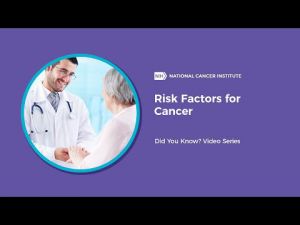Difference between revisions of "About-cancer/causes-prevention/risk/zh"
Jump to navigation
Jump to search
(Created page with "==癌症的危险因素==") |
(Created page with "癌症预防概述(PDQ®)–患者版本") |
||
| (11 intermediate revisions by the same user not shown) | |||
| Line 2: | Line 2: | ||
==癌症的危险因素== | ==癌症的危险因素== | ||
| − | [[File:T YGEESpPsGvWon Str0i5yQDPcpaJPPRxHTu9pgcvE.jpg|300px|right| | + | [[File:T YGEESpPsGvWon Str0i5yQDPcpaJPPRxHTu9pgcvE.jpg|300px|right|年龄,体重,接触致癌物和遗传因素会增加罹患癌症的风险。 从中了解更多信息您知道吗? 由NCI的监视,流行病学和最终结果(SEER)程序制作的视频。]] |
| − | + | 通常不可能确切地知道一个人为什么会患癌症而另一个人却不会。 但是研究表明,某些危险因素可能会增加一个人患癌症的机会。 (也有一些因素与较低的癌症风险有关。这些因素有时被称为保护性危险因素,或仅仅是保护性因素)。 | |
| − | + | 癌症的危险因素包括接触化学物质或其他物质,以及某些行为。 它们还包括人们无法控制的事物,例如年龄和家族史。 某些癌症的家族病史可能是可能遗传的癌症综合症的征兆。 (有关可导致癌症的遗传遗传突变的更多信息,请参见“遗传性癌症综合征”部分)。 | |
| − | + | 大多数癌症风险(和保护性)因素最初是在流行病学研究中确定的。 在这些研究中,科学家研究了一大批人,并将罹患癌症的人与未患癌症的人进行了比较。 这些研究可能表明,与未罹患癌症的人相比,罹患癌症的人或多或少会以某种方式行事或暴露于某些物质。 | |
| − | + | 这些研究本身不能证明某种行为或物质会致癌。 例如,发现可能是偶然的结果,或者真正的风险因素可能是可疑风险因素以外的其他因素。 但是,这种类型的发现有时会在媒体上引起关注,这可能导致有关癌症如何开始和扩散的错误观念。 (有关更多信息,请参见“常见癌症的神话和误解”页面)。 | |
| − | + | 当许多研究都指出潜在危险因素与癌症风险增加之间存在相似的关联,并且存在可能解释该危险因素实际上如何导致癌症的可能机制时,科学家们可以对两者之间的关系更有信心 。 | |
| − | + | 以下列表包括研究最多的已知或疑似癌症危险因素。 尽管可以避免其中一些风险因素,但其他风险因素(例如变老)却无法避免。 将您的接触限制在可避免的风险因素范围内,可以降低您罹患某些癌症的风险。 | |
| − | :* | + | :*年龄 |
| − | |||
| − | |||
| − | |||
| − | |||
| − | |||
| − | |||
| − | |||
| − | |||
| − | |||
| − | |||
| − | |||
| − | + | :*醇 | |
| − | + | :*致癌物质 | |
| + | |||
| + | :*慢性炎症 | ||
| + | |||
| + | :*饮食 | ||
| + | |||
| + | :*激素 | ||
| + | |||
| + | :*免疫抑制 | ||
| + | |||
| + | :*传染媒介 | ||
| + | |||
| + | :*肥胖 | ||
| + | |||
| + | :*辐射 | ||
| + | |||
| + | :*阳光 | ||
| + | |||
| + | :*烟草 | ||
| + | |||
| + | '''相关资源''' | ||
| + | |||
| + | 癌症预防概述(PDQ®)–患者版本 | ||
Latest revision as of 14:27, 31 October 2019
癌症的危险因素
通常不可能确切地知道一个人为什么会患癌症而另一个人却不会。 但是研究表明,某些危险因素可能会增加一个人患癌症的机会。 (也有一些因素与较低的癌症风险有关。这些因素有时被称为保护性危险因素,或仅仅是保护性因素)。
癌症的危险因素包括接触化学物质或其他物质,以及某些行为。 它们还包括人们无法控制的事物,例如年龄和家族史。 某些癌症的家族病史可能是可能遗传的癌症综合症的征兆。 (有关可导致癌症的遗传遗传突变的更多信息,请参见“遗传性癌症综合征”部分)。
大多数癌症风险(和保护性)因素最初是在流行病学研究中确定的。 在这些研究中,科学家研究了一大批人,并将罹患癌症的人与未患癌症的人进行了比较。 这些研究可能表明,与未罹患癌症的人相比,罹患癌症的人或多或少会以某种方式行事或暴露于某些物质。
这些研究本身不能证明某种行为或物质会致癌。 例如,发现可能是偶然的结果,或者真正的风险因素可能是可疑风险因素以外的其他因素。 但是,这种类型的发现有时会在媒体上引起关注,这可能导致有关癌症如何开始和扩散的错误观念。 (有关更多信息,请参见“常见癌症的神话和误解”页面)。
当许多研究都指出潜在危险因素与癌症风险增加之间存在相似的关联,并且存在可能解释该危险因素实际上如何导致癌症的可能机制时,科学家们可以对两者之间的关系更有信心 。
以下列表包括研究最多的已知或疑似癌症危险因素。 尽管可以避免其中一些风险因素,但其他风险因素(例如变老)却无法避免。 将您的接触限制在可避免的风险因素范围内,可以降低您罹患某些癌症的风险。
- 年龄
- 醇
- 致癌物质
- 慢性炎症
- 饮食
- 激素
- 免疫抑制
- 传染媒介
- 肥胖
- 辐射
- 阳光
- 烟草
相关资源
癌症预防概述(PDQ®)–患者版本
